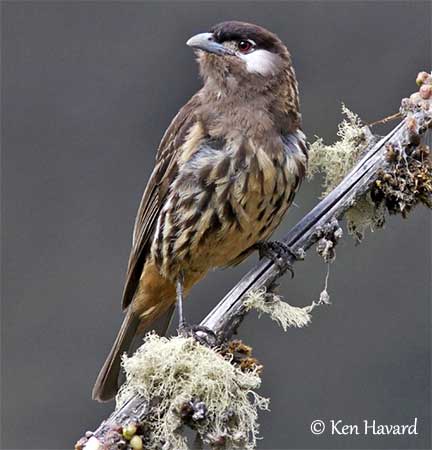
TO BE CONTINUED... Page 7
Text by Nicole Bouglouan
Photographers:
Roger Ahlman
Pbase Galleries Peru and Ecuador
Jean-Claude Billonneau
Photographe-témoin de la Beauté du Monde
Marc Chrétien
MURINUS
Maxime Dechelle
LEPAPARRAZO
Jean Michel Fenerole
Photos d’Oiseaux du monde
Steve Garvie
RAINBIRDER Photo galleries & Flickr Rainbirder
Ken Havard
My Bird Gallery & Flickr gallery 1 & Flickr gallery 2
Patrick Ingremeau
TAMANDUA
William Price
PBase-tereksandpiper & Flickr William Price
Dubi Shapiro
Dubi Shapiro Photo Galleries
Philippe et Aline Wolfer
OISEAUX D'ARGENTINE
These images and the text are subject to copyright and cannot be used without express authorization from the owners. Legal issues
Sources:
HANDBOOK OF THE BIRDS OF THE WORLD Vol 9 - by Josep del Hoyo - Andrew Elliot - David Christie - Lynx Edicions - ISBN: 8487334695
BIRDS OF SOUTH AMERICA – Passerines - by Robert S. Ridgely and Guy Tudor – HELM Field Guides – ISBN: 9781408113424
A GUIDE TO THE BIRDS OF MEXICO AND NORTHERN CENTRAL AMERICA by Steve N. G. Howell, Sophie Webb - Oxford University Press - ISBN: 0198540124
A GUIDE TO THE BIRDS OF COLOMBIA by Steven L. Hilty and William L. Brown - Princeton University Press – ISBN 069108372X
BIRDS OF PERU by Thomas S. Schulenberg, Douglas F. Stotz, Daniel F. Lane, John P. O’Neill, Theodore A. Parker III – Princeton University Press 2007– ISBN: 978-0-691-13023-1
Wikipedia, the free encyclopaedia
CREAGUS@Monterey Bay (Don Roberson)
Carolinabirds - BIRDS of THE WORLD - An Online Bird Book
The University of Melbourne - Manakin mania: the birds that dance with style
The bird and its nest, where everything starts…
Second part: The Passerines – Order Passeriformes
Page 6: Cotingidae, Pipridae and Tityridae
At the beginning of the breeding season and following several courtship displays, the nest-site is selected by the pair, or one of the members of the pair, and the nest is built within this area. For numerous species, the nest is the place where displays and copulation occur. It plays a very important role during the nesting period. It is the cradle of the chicks, the place where the adults feed them prior to their first flight towards independence.
The large family Cotingidae gathers passerine bird species only found in the New World. They range from S Mexico through most of tropical South America as far as N Argentina. Most of them are living at sea level in tropical lowland forest, but small numbers are found in the Andes, up to 4,000 metres of elevation at least, in high-altitude temperate forest.
As an example, the very local White-cheeked Cotinga is restricted to polylepis forest at 4,250 metres of elevation in a small area of Peru on the west slope of the Andes.

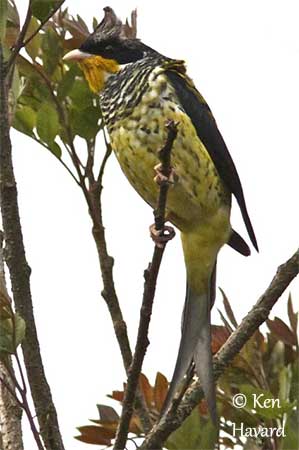
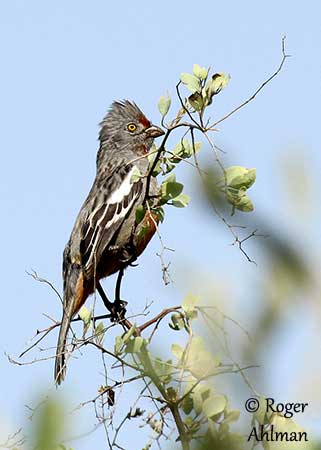
Depending on the species, the birds frequent swampy areas along large rivers but also hilly forests along the Andes, or forested shores of rivers and lakes and also swampy and seasonally flooded forest.
Actually, the choice of the habitat is probably closely related to fruit availability, foraging behaviour, courtship and nesting requirements.
Most of them feed mainly on fruit but the plantcutters consumes leaves and buds. The fruit-eaters are the main dispersers of the seeds of the large fruiting trees. The fruits eaten vary with the size of the bird.
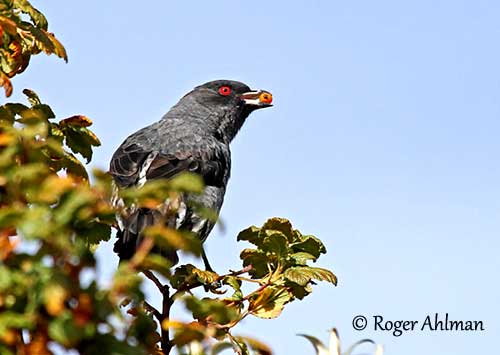
The bellbirds are exclusively frugivorous, and even the chicks are fed solely on fruit. In some Cotingidae species, snails and insects are taken too. They often forage solitary or in pairs, but the plantcutters may feed in small groups or sometimes in large flocks.
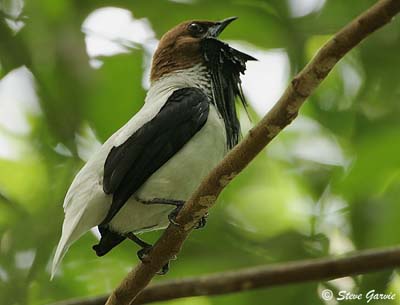
The family Cotingidae shows an extreme diversity both in size and plumage colours. They often have broad bills with hooked tips, strong legs and rounded wings. The sexual dimorphism is usually conspicuous with brightly coloured males and much duller females. Some males display plumes or wattles like umbrellabirds, bellbirds and the two cock-of-the-rock species. Males with well-developed adornments perform striking courtship displays with dominant males defending the perches where they display and mate. Of course, these ornaments are exhibited during the displays.
The females are duller and usually smaller than males, except for a few species.
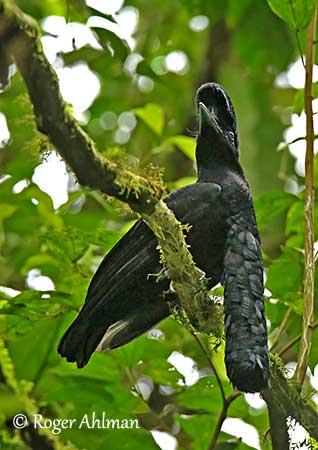
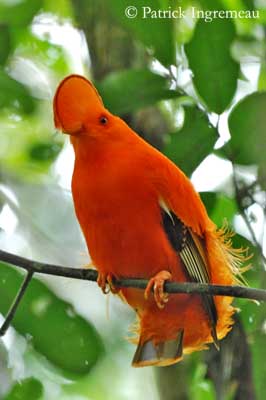
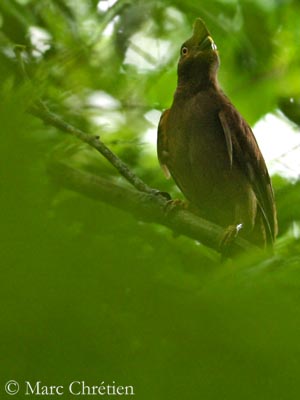
The calls heard during the displays are very loud and can be described as a bell-like call in bellbird species, booming notes in umbrellabirds or an extremely loud, piercing “pi pi y-o” of the Screaming Piha. This species probably compensates for his dull plumage with a shrill cry!
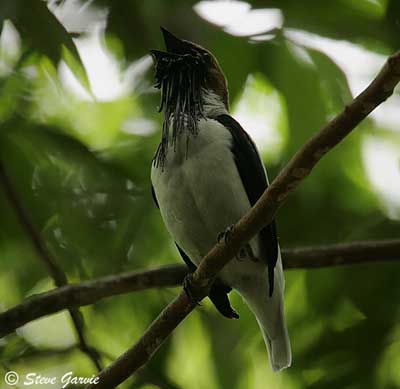
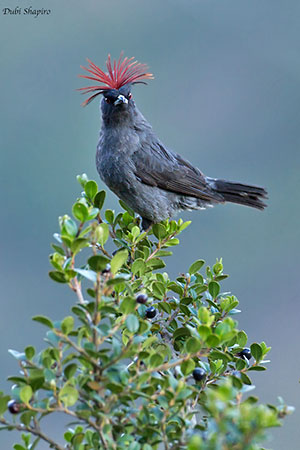
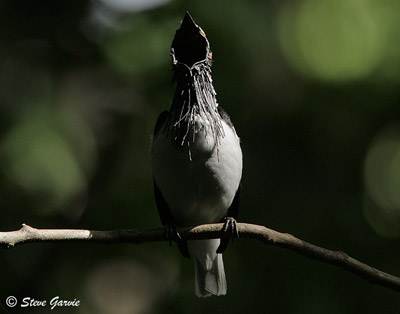
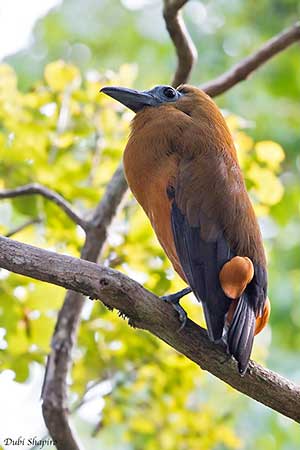
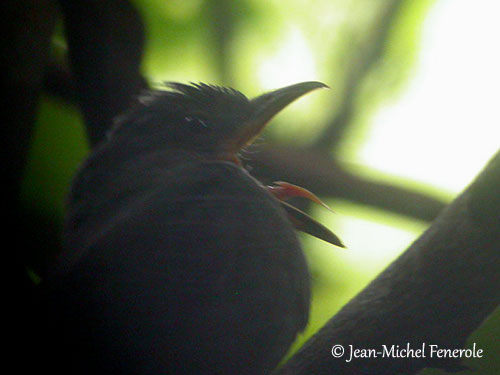
During the courtship displays, the males attempt to attract females. In the smaller species, the males are usually brighter coloured and less vocal than the medium-sized species which are less brightly coloured and more vocal. The males of the largest species have conspicuous ornaments such as wattles, plumes or lappets.
Numerous species, and especially the medium-sized species, tend to form “leks” and the Guianan Cock-of-the-rock is a good example of this behaviour. In this species, a lek may gather more than 50 males at the same site every year. Each male displays in its own “court” on the ground in the forest and in the low branches of trees just above. The surrounding perches are defended against rivals and some disputes may occur accompanied by raucous crowing.
The females inspect the displaying males, and when a female is ready to mate, she descends and lands close to a male until it hops and mounts her.
The bellbirds have different lek organization. The Bearded Bellbird forms groups of only three to four individuals spaced 100 metres or more apart. The loud hammer-like or bell-like calls are used to advertise the rivals.
The Capuchinbird displays also at leks. The site of the lek changes from year to year and the dominant male has to establish its dominance each season. A display area consists mainly of trees of about 25 metres high or less. The leks are usually in the upper canopy of the tall trees of the rainforest. In this species, male and female are similar in plumage.
Other cotingas with bright plumage perform aerial displays above the forest treetops.
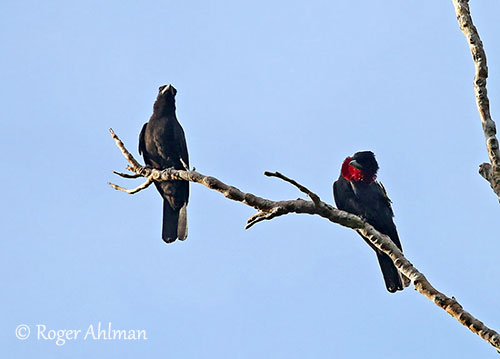
But a very different social organization is that of the Purple-throated Fruitcrow. This species lives in small groups of 3-8 individuals attending a single nest. They forage and roost together, take part in nest defence, mobbing both intruders and large predators.
Purple-throated Fruitcrow
Female left and male right
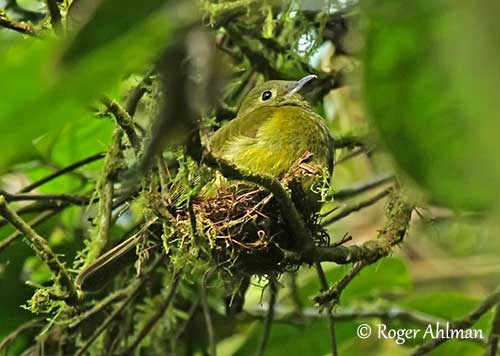
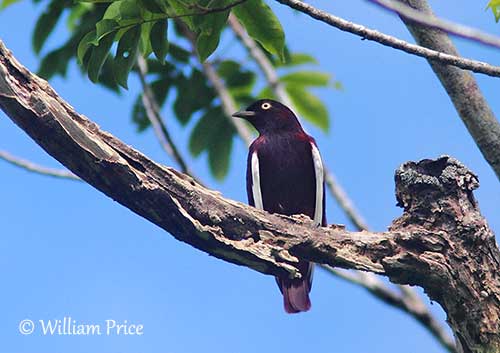
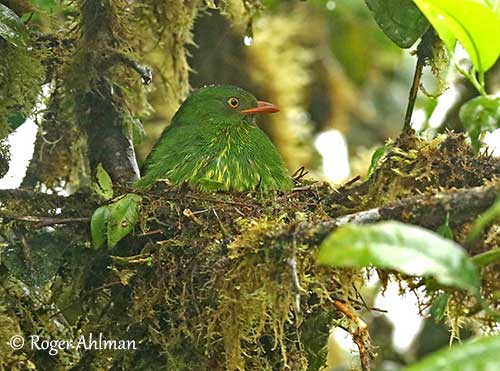
The Andean Cock-of-the-rock and the Guianan Cock-of-the-rock build a nest attached to a rock face, and both are living close to rocky gorges of mountain streams and rivers, and in forest near rocky outcrops and caves. These nests are made with mud and vegetation, and saliva is probably used as cement.
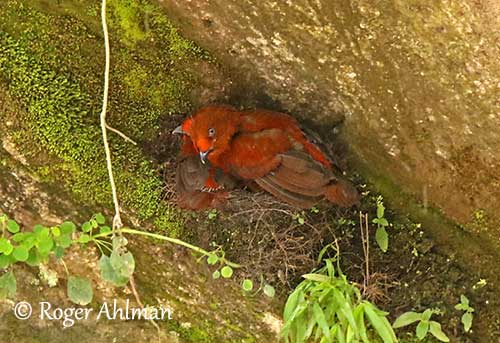
Female at nest with her chick
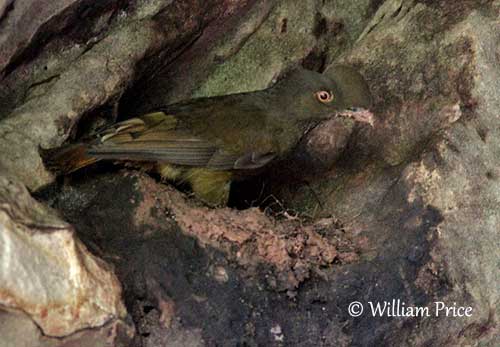
Nest-building by female
But more often, the nests of cotingas are placed in isolated trees, in areas adjacent to more or less open forest. This choice may reduce the risk of predation by arboreal mammals. They build open nests on or among branches in trees or shrubs.
The plantcutters that live in more open habitats build a shallow, cup-shaped, rather loose structure with thin dry twigs and lined with plant fibres and soft materials. It is placed inside a thorny scrub, up to 3 metres above the ground, sometimes higher in treefork.
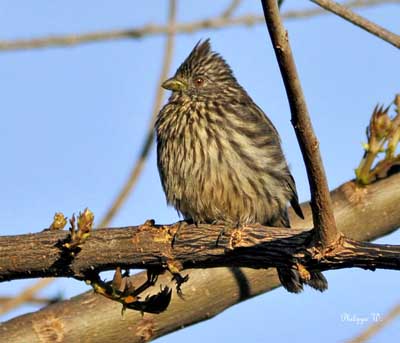
Female
The medium-sized Cotingidae such as fruitcrows, pihas and others, build tiny nests on fork of horizontal branch or between twigs. They are made of several interlaced twigs, vegetal fibres or tendrils, and form a tiny shallow cup. When the bird is on the nest, it appears like crouching on a perch and the small nest is almost invisible, like in the Olivaceus Piha.
The Bearded Bellbird female builds a loose structure, a small platform made with some thick twigs at the base. The shallow cup is made with finer twigs. These twigs are slightly curved and they interlock very well. The nest is situated in a tall tree in the forest, relatively close to the edge. It is built at about 2, 5 to 15 metres above the ground.
The nest of the Pompadour Cotinga is a deep open cup made of a few woody tendrils well adapted to the single egg laid by the female, whereas the Bare-necked Fruitcrow builds a very small cup-shaped structure made entirely of lichens and fine tendrils, placed on thick horizontal branch. The branch itself forms the bottom of the nest !
These small nests are as inconspicuous as possible in the tropical forest where nest predation is very high. The clutch size is usually a single egg, probably the consequence of the nest size. The eggs are generally dull in colour, buff or olive with darker spots or blotches around the broad end. The incubation is usually by female alone, and both parents may rear the chicks, depending on the species, but the female often performs alone the nesting duties. The young leave the nest at about one month of age.
The Cotingidae are threatened by habitat destruction caused by forest fragmentation which is the major problem for them. Forest destruction continues at an increasingly alarming rate, threatening the future of these beautiful birds. Numerous species are living in forest reserves and other protected areas, but the establishment of new ones is needed to ensure the survival of the Cotingidae.
The family Pipridae includes more than 50 species named manakins. They are found from S Mexico to N Argentina, Paraguay and S Brazil, and also on Trinidad and Tobago.
They live almost exclusively in forest and woodland, with most of them in humid tropical lowlands below about 1,000 metres of elevation, and a few species in dry forests, river forests and the subtropical Andes. Many species living in the forest interior feed regularly at forest edges where they can find fruiting trees.
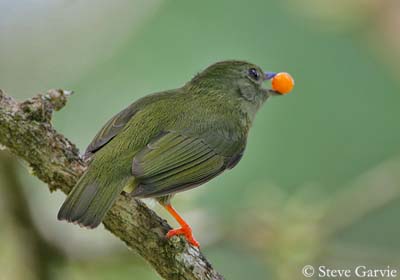
Female
These species need a year-round supply of small fruits that are the main food of the manakins, but they also consume insects and spiders. Fruits are plucked in rapid aerial sally from perch. The bird lands with the fruit in the bill and swallows it whole. They have a wide gape, allowing them to swallow fairly large fruits compared to their body size. They take the fruits of numerous species and are good dispersers of several plants.
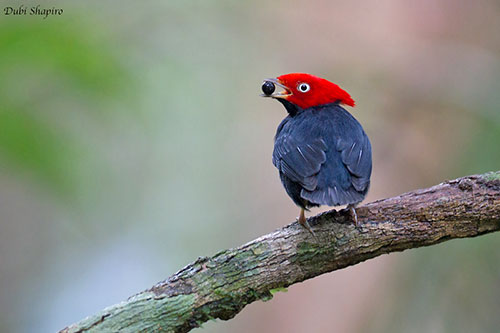
Insects and spiders are snatched from the vegetation following a brief flight. After heavy rains, termites usually swarm, and the birds hawk them from perches at treetops.
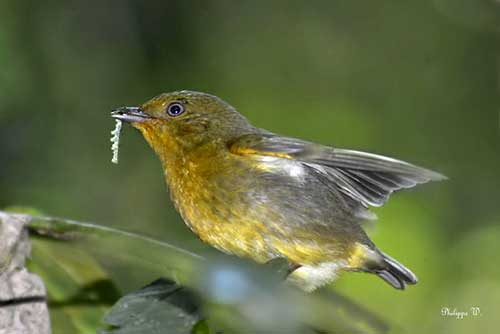
Band-tailed Manakin
Female
The manakins are pretty birds. They are small, with a weight ranging from 8 to 30 grams. Most of the adult males are largely black, with bright coloured patches, usually red, orange or yellow, but also blue or white. These colours are mainly found on the crown or other parts of the upperparts. They also have highly modified wing or tail feathers that are often used during the courtship displays, producing a grasshopper-like whirring sound.
Females and young birds are olive-green or green on the upperparts and paler below. Females and young of several species are very similar to each other.
They are generally rather silent except during the courtship displays. In addition to the mechanical sounds produced by the wing feathers, the males utter mainly simple, but strange or striking calls described as monosyllabic or sometimes more complex, usually a rapid phrase of a few notes or a trill.
The male Club-winged Manakin has modified secondary flight-feathers that produce a double mechanical sound during the displays “tip-beeuwww”. The wings are flicked downwards for the “tip” whereas the “beeuwww” is produced by the wings held up vertically above the back and vibrated.
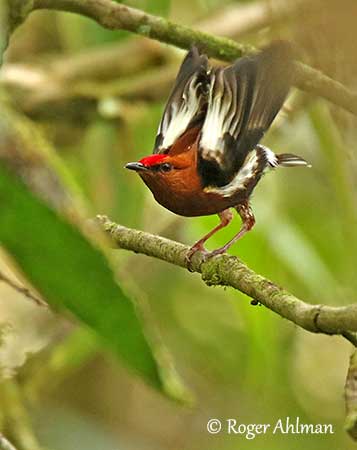
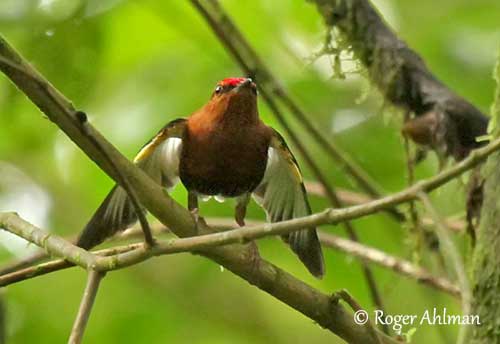
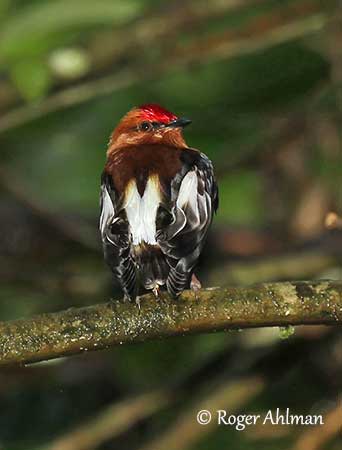
Club-winged Manakin
Displaying male
Several manakins produce mechanical sounds during a rapid, stereotyped fly-in to the display perch. The Crimson-hooded Manakin, the Band-tailed Manakin and the Wire-tailed Manakin produce a soft “kloop” with the wings while at the lowest point of the flight just before landing on a perch.
But several other species make various sounds with the wings while displaying, and the bright-coloured wing-patches are displayed at the same time.
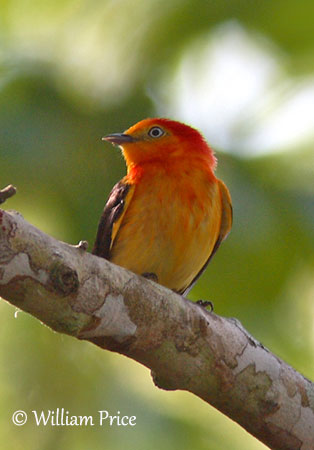
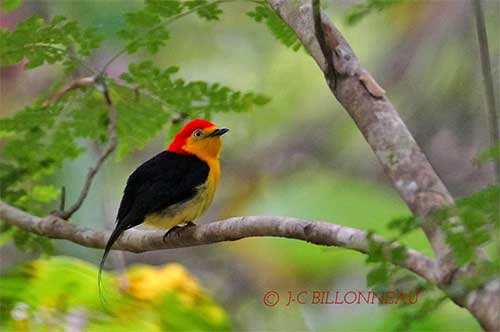
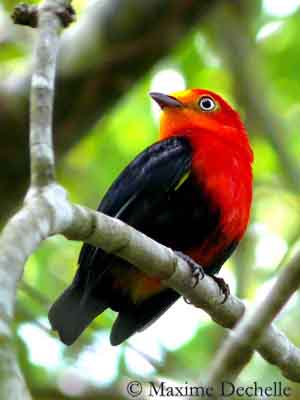
The habitat must offer display sites where the males spend most of their time. But these sites need to receive sunlight in the early morning and the afternoon, the two times of the day when this activity is at its height.
There is no pair bond in manakins. When a female is ready to mate, she selects a male in a lek and the copulation occurs following the male’s displays.
The White-fronted Manakin displays near the ground in dense forest patches where there is most light, and the male uses two sites, one in the morning and the second one in the afternoon, when they are well illuminated by the sunlight.
The Golden-headed Manakin displays higher than other males, between 5 and 15 metres above the ground. It displays on a high perch illuminated by the sunlight through gaps in the canopy.
In many manakin species, the males display in groups or “leks” always in the same place year after year. Except during the moulting period, the male spends almost its entire life on the lek at which it may be present for up to 90% of the daylight hours, with brief absences for foraging. This is typical of the Golden-headed Manakin.
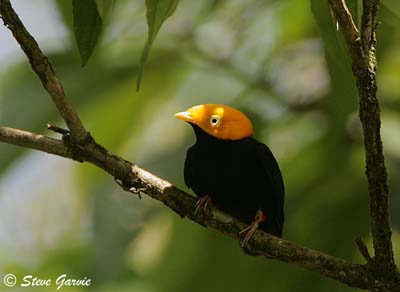
Some species like the Long-tailed Manakin, perform complex displays with several males. The alpha male shares a horizontal perch with one or more beta males. It calls near the perch until a second male lands at its side and both perform a duet. Then, they fly to the perch for a jumping display. The alpha male flutters up into the air, like hanging in mid-air while calling before to drop back onto the perch. The beta male does the same display and the sequence is repeated several times while accelerating, until the alpha male calls loudly. Then, one or both birds fly off into the undergrowth.
When a female lands on the perch, the males face her and jump one after the other while they move forwards. If the female remains on the perch after this display, the alpha male flutters around her while exposing the blue and red patches of its plumage, and copulation occurs, usually on the same perch.
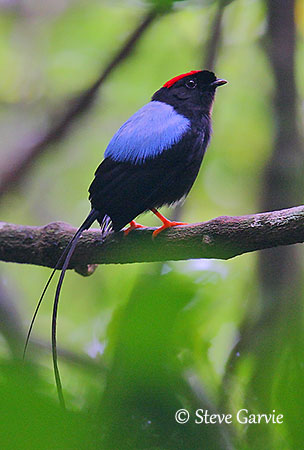
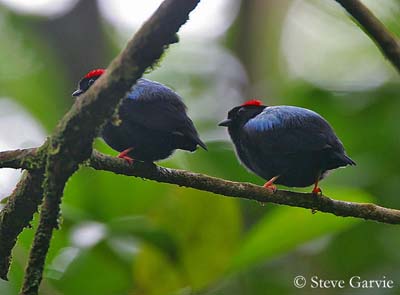
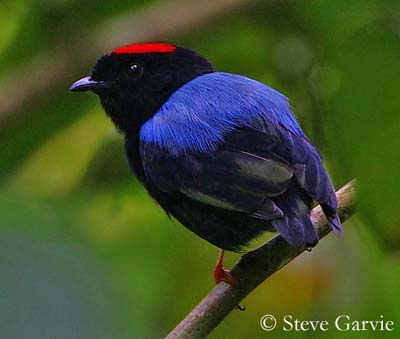
Displaying males
The manakins are solitary nesters, and the cryptic female is the only one concerned with the nest. In many species, the nest is tiny, flimsy and very small like the nests of Trochilidae. Some nests are so loosely woven that the contents can be seen through the bottom. The nests are usually built near the ground, sometimes very low down, and some of them are camouflaged. The breeding season extends over several months.
The nest is a small cup made of plant fibres, leaf midribs and other fine material. It is suspended in a fork between two twigs to which it is attached by spider webs or rhizomorphs, or both. Some nests are covered on the outside with dead leaves or moss, and may have a “tail” of plant material hanging from below it. Such nests are almost invisible among the vegetation.
The nest of the Orange-crested Manakin is made with plant fibres, but it is so loosely woven that it is easy to see the content from below. But the incubating female usually adopts a very upright posture, with the breast well above the rim while tail and undertail-coverts are in view and angled downwards. The visual impression is that of a perched bird, and the nest does not appear.

Orange-crested Manakin
Female
The eggs are very pale with dark markings. The clutch size of all species is almost invariably of two eggs. The incubation lasts between 16 and 19 days and performed by the female alone. The chicks are fed with a mixture of insects and small fruits carried by the female in her throat and sometimes in the bill. They fledge 13-15 days after hatching, but nest predation is very high and this period is less well documented.
The nesting success of Pipridae is very low due to predation, but manakins are among the most abundant birds in many Neotropical forest areas. However, several species are more or less threatened by habitat loss through deforestation, forest clearance for human settlements, road-building and recreational activities.
The future conservation of Pipridae species depends mainly on protection of suitable forest areas.
The family Tityridae is already present on the website: Family Tityridae
It was formerly included in the family Tyrannidae.